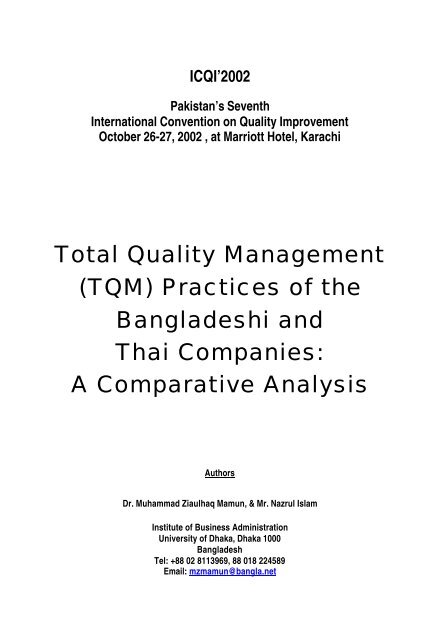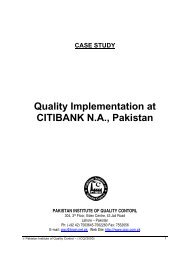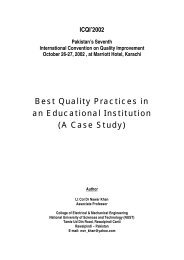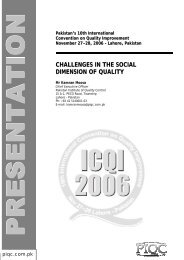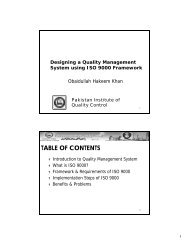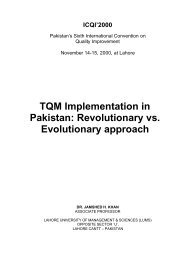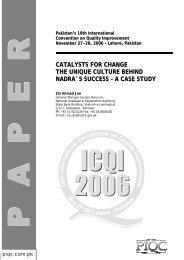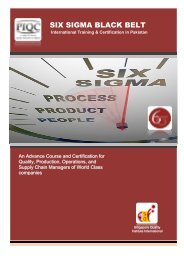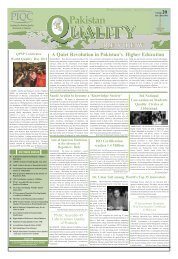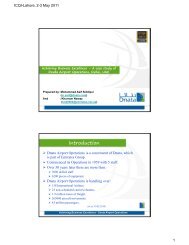Total Quality Management (TQM) Practices of the ... - PIQC
Total Quality Management (TQM) Practices of the ... - PIQC
Total Quality Management (TQM) Practices of the ... - PIQC
- No tags were found...
Create successful ePaper yourself
Turn your PDF publications into a flip-book with our unique Google optimized e-Paper software.
ICQI’2002Pakistan’s SeventhInternational Convention on <strong>Quality</strong> ImprovementOctober 26-27, 2002 , at Marriott Hotel, Karachi<strong>Total</strong> <strong>Quality</strong> <strong>Management</strong>(<strong>TQM</strong>) <strong>Practices</strong> <strong>of</strong> <strong>the</strong>Bangladeshi andThai Companies:A Comparative AnalysisAuthorsDr. Muhammad Ziaulhaq Mamun, & Mr. Nazrul IslamInstitute <strong>of</strong> Business AdministrationUniversity <strong>of</strong> Dhaka, Dhaka 1000BangladeshTel: +88 02 8113969, 88 018 224589Email: mzmamun@bangla.net
Pakistan’s Seventh International Convention on <strong>Quality</strong> Improvement (ICQI’2002) 2TOTAL QUALITY MANAGEMENT (<strong>TQM</strong>) PRACTICESOF THE BANGLADESHI AND THAI COMPANIES:A COMPARATIVE ANALYSISbyDr. Muhammad Ziaulhaq MamunAssociate Pr<strong>of</strong>essorInstitute <strong>of</strong> Business AdministrationUniversity <strong>of</strong> Dhaka, Dhaka 1000, Bangladesh&Mr. Nazrul IslamAssistant Pr<strong>of</strong>essorBusiness Administration DisciplineKhulna University, BangladeshABSTRACTThe comparative analysis <strong>of</strong> <strong>TQM</strong> practices between Bangladesh and Thai companiesclearly shows planning, implementation and operational differences. Bangladeshicompanies portray <strong>TQM</strong> vision consciousness but in many cases <strong>the</strong>y fall victim <strong>of</strong> treating<strong>TQM</strong> as a fad ra<strong>the</strong>r than an essential component. The management principles are narrowlyviewed, communicated and understood in Bangladeshi companies even with well-documentedprocedures and instructions. All <strong>the</strong> Bangladeshi companies concerned are well equipped andsuccessful to some extent in achieving customer satisfaction with regard to product and servicequality excellence, but <strong>the</strong>y lack close working relationships, interest groups and <strong>the</strong> promotingaspect <strong>of</strong> working environment. Bangladeshi firms make a visible effort in empowerment <strong>of</strong>quality control circles but apparently follow a comparatively rigid hierarchical structure, butnone<strong>the</strong>less are able to assure quality. In terms <strong>of</strong> organization and distribution, all <strong>of</strong> <strong>the</strong>concerned companies are suitably equipped and positioned, but suppliers are not benchmarkedwith respect to specific criteria and special quality ratings in terms <strong>of</strong> product attributes and<strong>the</strong>refore information regarding supplier reliability is not available in any objective form.Bangladeshi firms have much to achieve in <strong>the</strong> areas <strong>of</strong> creativity and R&D, and <strong>the</strong>refore,investment in those areas is imperative.Key words: <strong>TQM</strong>, Vision, Operational Philosophy, MBO, <strong>Quality</strong> Circle, Supply Chain, <strong>Quality</strong>Assurance, <strong>Quality</strong> RatingISSUEFrom an economically conservative culture Bangladesh is gradually progressing towards <strong>the</strong>new era <strong>of</strong> open market policies and globalization. Industrially <strong>the</strong> country is stillunderdeveloped. The concept <strong>of</strong> quality management is recent in Bangladesh and <strong>the</strong> country is in apartial awareness state. The few organizations that have adopted quality management practiceshave experienced an overall improvement in corporate performance. In nearly all cases, <strong>the</strong>se© Pakistan Institute <strong>of</strong> <strong>Quality</strong> Control www.piqc.com.pk
Pakistan’s Seventh International Convention on <strong>Quality</strong> Improvement (ICQI’2002) 3organizations achieved better employee relations, higher productivity, better customer satisfaction,increased market share and improved pr<strong>of</strong>itability. Recently a number <strong>of</strong> companies are trying tomaintain ISO standards and to get due certification to run <strong>the</strong>ir businesses efficiently and to have acompetitive edge, both in domestic and global market. The lowering <strong>of</strong> trade barriers in today’sworld implies that opportunity to compete will be available to everyone and that will be basedon quality (Khader, 1997). The fact that quality is <strong>the</strong> most potent competitive weapon for anyorganization is being well realized, though slowly, in <strong>the</strong> industrial sector <strong>of</strong> Bangladesh. Thus amovement has started to strive for higher quality in products and services and even forpracticing quality management, which is a relatively new concept. The economic commitment <strong>of</strong><strong>the</strong> government <strong>of</strong> Bangladesh is also very much commendable with <strong>the</strong> present trend <strong>of</strong>globalization. Government has realized that improvement in <strong>the</strong> manufacturing sector withprivate investment with export orientation as well as foreign investment will facilitatecompetition and expedite <strong>the</strong> drive for world-class quality.Implementation <strong>of</strong> large-scale change such as <strong>TQM</strong> will inevitably face resistance, which shouldbe addressed directly by change agents. A key element <strong>of</strong> <strong>TQM</strong> is working with customers, and<strong>the</strong> notion <strong>of</strong> soliciting feedback/expectations from customers/clients and collaborating with<strong>the</strong>m (Frehr, 1997). Perhaps with customers defining quality, is a radical one in many agencies,particularly those serving involuntary clients (e.g., Protective services). At ano<strong>the</strong>r level,management resistance to employee empowerment is likely. They may see decision-makingauthority in zero sum terms, i.e., if employees have more involvement in decision-making,managers will have less (Taha, 1982). In fact, one principle in employee involvement is thateach level will be more empowered and managers lose none <strong>of</strong> <strong>the</strong>ir fundamental authority.There will undoubtedly be changes in <strong>the</strong>ir roles, however. As noted, <strong>the</strong>y will spend less timeon control and more on facilitation. For many traditional managers, this transition will requireteaching, training, self-reflection, and time, as well as, assurances from upper management that<strong>the</strong>y are not in danger <strong>of</strong> being displaced.With above scenario and <strong>TQM</strong> practices in mind this study is to make a comparative analysisbetween Thai and Bangladeshi companies who are actively practicing total quality managementmeasures. Here <strong>TQM</strong> practices in <strong>the</strong> Thai Bridgestone Company, a quality leader inmanufacturing, is taken as a subjective standard and compared those practices with <strong>the</strong> ones inthree Bangladeshi private companies, namely, BOC Bangladesh Ltd., Rahimafrooz BatteriesLtd., and Beximco Infusions Ltd., <strong>the</strong> recognized leaders in <strong>the</strong> industry <strong>the</strong>y operate (Mamun,1999). The study also looked into relative positioning and analyzing inadequacies, if any, <strong>of</strong> <strong>the</strong>companies in terms <strong>of</strong> <strong>TQM</strong> and gave general recommendations considering short-term andlong-term strategies for <strong>the</strong> Bangladeshi companies.The report assiduously concentrates on a comparative analysis with regard to <strong>TQM</strong> but <strong>the</strong>nature <strong>of</strong> <strong>the</strong> analysis does not restrict itself to <strong>the</strong> boundaries <strong>of</strong> <strong>TQM</strong>. Various subjectiveperspectives are provided where deemed required. It may be mentioned here that <strong>the</strong> selection <strong>of</strong><strong>the</strong> Bangladeshi companies was not chosen at random, ra<strong>the</strong>r <strong>the</strong> leading companies in terms <strong>of</strong><strong>TQM</strong> were consciously preferred. The companies follow various principles <strong>of</strong> <strong>TQM</strong> system inorder to serve society with <strong>the</strong>ir products and services. The parameters used for <strong>the</strong> comparativeanalysis includes vision, operational philosophy, sense <strong>of</strong> management by objective (MBO),customer satisfaction, making things right at <strong>the</strong> first time, making everything work better,quality assurance system, quality control circle, strong supply chain, special quality ratingsystem, continuous improvement and diversified services (Petrarolo 1998). These practicingissues supplemented by comparative pictures <strong>of</strong> <strong>the</strong> Thai and Bangladeshi companies arediscussed below.© Pakistan Institute <strong>of</strong> <strong>Quality</strong> Control www.piqc.com.pk
Pakistan’s Seventh International Convention on <strong>Quality</strong> Improvement (ICQI’2002) 4VISION“Serving society with products <strong>of</strong> superior quality” was <strong>the</strong> vision <strong>of</strong> <strong>the</strong> founder <strong>of</strong>Bridgestone Shojiro Ishibashi and even today its incorporation remains deeply rooted in<strong>the</strong> company’s culture with emphasis on real contribution and well being <strong>of</strong> people. The presentpresident <strong>of</strong> Bridgestone Mr. Kaizaki’s ambition is to become much more than just one <strong>of</strong> <strong>the</strong>biggest tire manufacturers in <strong>the</strong> world. BOC Bangladesh Ltd., on <strong>the</strong> o<strong>the</strong>r hand, althoughoperating in <strong>the</strong> Sou<strong>the</strong>ast Asia region since <strong>the</strong> days <strong>of</strong> British India, it was not until <strong>the</strong> early1990s that BOC, <strong>the</strong> largest manufacturer <strong>of</strong> welding electrodes and gasses, felt <strong>the</strong> need forquality leadership. Therefore it would be fair to assess BOC as a late adopter <strong>of</strong> a <strong>TQM</strong> vision.But it must also be remembered that this does not undermine its integrity in implementing <strong>TQM</strong>practices in its organization culture. BOC personnel constantly remind <strong>the</strong>mselves that “qualityis defined by <strong>the</strong> customer” and <strong>the</strong>ir <strong>TQM</strong> practices go beyond ISO-9002 certificationstandards.The activities <strong>of</strong> Rahimafrooz management always gave <strong>the</strong> impression that <strong>the</strong>y indeed had avision <strong>of</strong> <strong>TQM</strong> embedded in <strong>the</strong>m since <strong>the</strong> incorporation in 1954. Receiving its ISOcertification in 1997, Rahimafrooz continues to satisfy customers through <strong>the</strong>ir quality productsand services. Rahimafrooz basically follows <strong>the</strong> <strong>TQM</strong> concepts <strong>of</strong> Edward Deming (Rao et al.,1996) as per vision realization. The vision is expressed in <strong>the</strong>ir corporate mission statement“ensure quality product and service excellence for total customer satisfaction.” Incorporated in1990 and receiving its ISO 9001 certification in 1996, <strong>the</strong> Beximco Infusions Ltd. makes it clearthat its pursuit for <strong>TQM</strong> is not just words. This relatively new company realizes that a constant<strong>TQM</strong> vision is <strong>the</strong> only way for <strong>the</strong> company to survive in <strong>the</strong> market <strong>of</strong> intravenous fluids.Apparently it appears that vision dictates terms in Thai Bridgestone. Among <strong>the</strong> Bangladeshicompanies BOC portrays <strong>TQM</strong> vision consciousness and Rahimafrooz’s activities displaysuccessful <strong>TQM</strong> vision implementation in its organization culture. BIL, like o<strong>the</strong>rs,communicate determination on ensuring a <strong>TQM</strong> culture incorporation, but <strong>the</strong>y may fall victimto treating <strong>TQM</strong> as a “fad” ra<strong>the</strong>r than a essential component in its log run strategy. Theconclusion is drawn from <strong>the</strong> fact that no formal attempts to quantify <strong>the</strong> effects <strong>of</strong> ISOcertification have been undertaken in Bangladeshi organizations (Taormina, 1996)). Topmanagement <strong>TQM</strong> vision consciousness, which in turn would determine proceedings <strong>of</strong> <strong>the</strong>Bangladeshi companies, is suggested.OPERATIONAL PHILOSOPHYDedication, commitment, creative innovation and R&D accentuate <strong>the</strong> operationalphilosophy <strong>of</strong> Thai Bridgestone. BOC, on <strong>the</strong> o<strong>the</strong>r hand, emphasizes on preparing anddeveloping people in making a distinction in <strong>the</strong> quality <strong>of</strong> organizational performance. In <strong>the</strong>irview, much is required beyond ISO 9002 through practicing <strong>TQM</strong>. Rahimafrooz’s operationalphilosophy can be observed in its quality policy <strong>of</strong> ensuring that all its products manufacturedand sold ei<strong>the</strong>r meet or exceed customer requirements, with obvious weight on customersatisfaction. Rahimafrooz follows Deming’s operational philosophy, in <strong>the</strong> form <strong>of</strong> <strong>the</strong> seven Ps,which are: positive commitment, planning, participation, process control, problem identification,problem elimination, and permanence (Goetsch and Davis, 1997).Beximco Infusions meet <strong>the</strong>ir quality standard not only by meeting specifications but also byensuring reproducibility <strong>of</strong> <strong>the</strong> processes in each stage <strong>of</strong> <strong>the</strong> production, packaging, qualitycontrol, storage and distribution. In comparison with Thai Bridgestone in terms <strong>of</strong> operationalphilosophy, BOC and BIL have much to achieve in <strong>the</strong> areas <strong>of</strong> creativity and R & D and© Pakistan Institute <strong>of</strong> <strong>Quality</strong> Control www.piqc.com.pk
Pakistan’s Seventh International Convention on <strong>Quality</strong> Improvement (ICQI’2002) 5<strong>the</strong>refore, investment in those areas is suggested for <strong>the</strong> concerned companies. In contrast to itsBangladeshi counterparts, Rahimafrooz’s venture into Solar Photovoltaic Power systems andtechnological collaboration with leading international manufacturers depict <strong>the</strong> company’sawareness <strong>of</strong> <strong>the</strong> importance <strong>of</strong> R&D investment requirements.MANAGEMENT BY OBJECTIVE (MBO)From <strong>the</strong> top level to <strong>the</strong> bottom, Bridgestone people are cognizant about <strong>the</strong> objectives,both organizational and individual, <strong>of</strong> <strong>the</strong> company along with <strong>the</strong> founder ShojiroIshibashi’s vision, which implies <strong>the</strong> assimilation <strong>of</strong> <strong>the</strong> MBO concept. Apparently MBOconcept has also made its way into <strong>the</strong> BOC culture. BOC quality control personnel feel thatacquiring and sustaining ISO 9002 is a useful strategy to manage human resources developmentpr<strong>of</strong>ession in transition, however, according to <strong>the</strong>m it is equally important to start thinkingbeyond ISO 9002 and turn <strong>the</strong>se thinking into operational elements in all major functional areas.Rahimafrooz’s MBO are found in <strong>the</strong> form <strong>of</strong> <strong>the</strong> 5S Japanese technique <strong>the</strong>y follow both in <strong>the</strong>organizational and individual level: seiry (differentiating between necessary, unnecessary anddisposable), saiton (a layout satisfying all requirements), saiso (emphasis on a clean workenvironment), setuske (routine effectiveness <strong>of</strong> operations), and seiketsu (maintaining anorganized standard). The interaction between and accountability to its constituencies(employees, customers, suppliers, fellow citizens and shareholders) largely shape MBOpractices in Beximco Infusions. In Thai Bridgestone MBO concept is well communicated andunderstood. In BOC, Rahimafrooz and BIL <strong>the</strong> MBO concept incorporation is pronounced byISO certification, <strong>the</strong> 5Ss and constituency interests respectively. MBO concept extensions forBangladeshi firms, in general, and BOC, in particular, are advised.WORKING TO SATISFY CUSTOMERSAmulti-brand strategy is <strong>the</strong> cornerstone <strong>of</strong> Bridgestone marketing to satisfy its customers.Through developing and promoting comprehensive product lines, working closely withauto-makers, taking advantage <strong>of</strong> its international network and efficient cost performancethrough retreadability, Bridgestone is able to satisfy its customers worldwide. BOC’s attitudetowards its customer satisfaction is found in <strong>the</strong>ir thinking <strong>the</strong> customer defines quality. They tryto satisfy <strong>the</strong> customer in all <strong>the</strong> quality aspects, putting equal emphasis on service quality alongwith product quality. Rahimafrooz not only ensures customer satisfaction through providingquality products but also has a good after sales service policy. Battery failure within 90 days <strong>of</strong>purchase results in a replacement with no questions asked and from <strong>the</strong> 91st day up to <strong>the</strong> 365thday if any defects occur, a free-cost-repair is gladly provided. Through rigid implementation <strong>of</strong>quality assurance practices BIL ensures uniform quality and in turn customer satisfaction.All <strong>the</strong> companies concerned are well equipped and successful in achieving customersatisfaction with regard to product and service quality excellence. But in comparison with ThaiBridgestone with <strong>the</strong> exception <strong>of</strong> Rahimafrooz, close-working relationships among <strong>the</strong>company and interest groups is not observable. The promoting aspect <strong>of</strong> working to satisfycustomers is also ano<strong>the</strong>r non-observable element. The following enactment are <strong>the</strong>reforesuggested:(i)Developing a database tailored to accumulate significant pieces <strong>of</strong> informationcontinuously from various interests groups, addressing problem areas from <strong>the</strong>acquired data and taking prompt action for improvements.© Pakistan Institute <strong>of</strong> <strong>Quality</strong> Control www.piqc.com.pk
Pakistan’s Seventh International Convention on <strong>Quality</strong> Improvement (ICQI’2002) 6(ii) Educating <strong>the</strong> target audience about <strong>the</strong> meaning <strong>of</strong> ISO 9000 series and certificationthrough various media. The difference between earning an ISO certification andmaintaining one should also be emphasized.(iii) Product promotion through TV commercials, print-media and radio. Maintaining ahigh pr<strong>of</strong>ile through local celebrity endorsements, local involvement in various socialprograms and providing innovative solutions in a crisis situation. The localpromotional aspects do not apply to BIL due to general legal constraints.MAKING THINGS RIGHT AT THE FIRST TIMETo survive in a market <strong>of</strong> intense competition Bridgestone through advanced technologycoupled with human motivation has secured a competitive edge. Empowered employeeslook after <strong>the</strong>ir own work. Teamwork in small groups has effectively attained desired level <strong>of</strong>productivity and in turn made things right <strong>the</strong> first time. BOC concentrated mainly reducingwastage as per standards and maintained special quality control charts in <strong>the</strong> production sector <strong>of</strong>welding division in an effort to succeed in <strong>the</strong> initial attempt. Compliance with <strong>the</strong> ISO elementsvirtually ensures product conformity to standards in <strong>the</strong> case <strong>of</strong> Rahimafrooz batteries. InBeximco Infusions, quality assurance practices dictate terms in success production at <strong>the</strong> initialattempt. All <strong>the</strong> companies follow <strong>the</strong>ir respective ISO standards and virtually ensure that“making things right at <strong>the</strong> first time,” which is <strong>the</strong> essence <strong>of</strong> <strong>TQM</strong>, is achieved.MAKING EVERYTHING WORK BETTERThai Bridgestone makes great tires by questioning <strong>the</strong> conventional wisdom <strong>of</strong> tire designand finding new ways to resolve old issues. Their vast R&D network in effect achievestimely solutions and appropriate innovations. BOC is an unlikely contestant in <strong>the</strong> field <strong>of</strong>innovativeness in <strong>the</strong> light <strong>of</strong> questioning old conventions, ra<strong>the</strong>r it may seen as a company,which <strong>of</strong>ten follows in <strong>the</strong> footsteps <strong>of</strong> its parent entity. Among <strong>the</strong> three Bangladeshicompanies Rahimafrooz is unquestionably <strong>the</strong> one who not only tries to incorporate in itsproducts new concepts but also <strong>the</strong> one who tries to excel in innovativeness with acomparatively stronger R&D. BIL depends on its hierarchical structure to provide suggestionsin making everything work better.Thai Bridgestone excels in making everything work better. Rahimafrooz makes a visible effortin this regard through employee empowerment in quality control circles. BOC apparentlyfollows in <strong>the</strong> footsteps <strong>of</strong> its parent entity in making everything better while BIL depends on acomparatively rigid hierarchical structure for this purpose. With respect to <strong>the</strong> prevailingsituation in Bangladesh, <strong>the</strong> following executions are suggested:Taking R&D initiatives especially, utilizing <strong>the</strong> specialized skills <strong>of</strong> university students andresearchers in dealing with various problems and providing innovative solutions.Seeking specialized talent through arranging and financing science and technology expositions.QUALITY ASSURANCE SYSTEM (QAS)Thai Bridgestone set a quality assurance system following <strong>the</strong> 4Ms criteria to achieve <strong>the</strong>highest quality products. The 4Ms are (i) machinery (characterized by advanced machineryand state-<strong>of</strong>-<strong>the</strong>-art technology for <strong>the</strong> production process), (ii) materials (characterized bycareful testing <strong>of</strong> raw materials obtained from <strong>the</strong> parent company and o<strong>the</strong>r reliable suppliers,and <strong>the</strong> use <strong>of</strong> kanban system), (iii) methods (characterized by effective quality control circles,implementation <strong>of</strong> MBO concept and strong commitment <strong>of</strong> work force), and (iv) manpower(characterized by continuing seminars, workshops and business learning trips).© Pakistan Institute <strong>of</strong> <strong>Quality</strong> Control www.piqc.com.pk
Pakistan’s Seventh International Convention on <strong>Quality</strong> Improvement (ICQI’2002) 7BOC strictly follows <strong>the</strong> ISO standards for quality assurance. <strong>Quality</strong> control circles are alsoeffectively managed. Rahimafrooz’s quality assurance, besides <strong>the</strong> maintained standard comesfrom <strong>the</strong> empowerment <strong>of</strong> employees and its continual improvement sequence <strong>of</strong> Plan, Do,Check and Act (Dean and Evans, 1994). BIL after determining <strong>the</strong> eleven major areas and stages<strong>of</strong> its product’s life cycle used a comprehensive quality assurance procedure in a persistent effortto sustain compliance to ISO standards. Hence it can be said that well documented proceduresand instructions have been established and maintained throughout <strong>the</strong> Bangladeshi organizationsdefining processes, responsibilities and authorities in terms <strong>of</strong> quality assurance as per ISOrequirements. What is more required is <strong>the</strong> explanation and in depth understanding <strong>of</strong> <strong>the</strong>procedures and instructions.QUALITY CONTROL (QC) CIRCLEQC circle <strong>of</strong> Bridgestone, a small working group <strong>of</strong> seven, through employee participationand empowerment has been able to come up with innovative solutions to problemsconstantly and proved its worth and effectiveness. In placing a lot <strong>of</strong> effort in managing qualitycontrol circles BOC has improved its customer handling techniques, scheduling review meetingand call charts. Rahimafrooz has developed clearly defined roles and functions <strong>of</strong> a quality circleorganization consisting <strong>of</strong> steering committee, facilitator, circle leader and QC members. Each<strong>of</strong> <strong>the</strong> 24 QC circles <strong>of</strong> Rahimafrooz consists <strong>of</strong> 8-10 members who solve problems throughparticipation.In contrast to quality circles BIL has a hierarchical quality management system (HQMS)comprising <strong>of</strong> top management, a quality manager, a work manger, head <strong>of</strong> quality control, head<strong>of</strong> production, a quality control <strong>of</strong>ficer, a quality assurance <strong>of</strong>ficer and three o<strong>the</strong>r employees.Thai Bridgestone’s quality control circles have proven to be effective. Rahimafrooz’s QCcircles, characterized by employee empowerment, have actually worked quite well and havebeen able to accomplish results. BOC and BIL maintain a comparatively less flexible QC circlesin terms <strong>of</strong> employee empowerment, but none<strong>the</strong>less are able to assure quality. Hence what isrequired is QC circles with adequate empowerment and close monitoring.INTERORGANIZATIONAL CHAINInter-organizational supply chain includes suppliers, organization and <strong>the</strong> distributors.Bridgestone acquires raw materials from its parent company and local sources anddistributes its products through its strong international networks. For BOC Bangladesh, <strong>the</strong>concerned company evaluates reliability <strong>of</strong> suppliers and has a strong distribution network.Employees have say in <strong>the</strong> quality <strong>of</strong> <strong>the</strong> materials supplied and are encouraged to providesuggestions. BIL similarly evaluates reliability <strong>of</strong> suppliers and has a strong distributionnetwork.In terms <strong>of</strong> organization and distribution, all <strong>of</strong> <strong>the</strong> concerned companies are suitably equippedand positioned. Individual evaluations <strong>of</strong> suppliers are carried out in <strong>the</strong> Bangladeshi companies,but suppliers are not benchmarked with respect to specific criteria and <strong>the</strong>refore informationregarding supplier reliability is not available in any objective form. Bridgestone is free <strong>of</strong> thisconstraint as Western countries, by and large, practice maintaining supplier rating systems,which provide objective information on relevant criteria. Recently, in USA online bidding <strong>of</strong>suppliers has come into being, where a selected number <strong>of</strong> top rated suppliers are contacted andrequested to bid on major international tenders at a specified time. The whole bidding processtakes place online; openness is observed efficiency is dramatically increased and <strong>the</strong> award is© Pakistan Institute <strong>of</strong> <strong>Quality</strong> Control www.piqc.com.pk
Pakistan’s Seventh International Convention on <strong>Quality</strong> Improvement (ICQI’2002) 8given based on objective comparisons. Above all compliance with terms and conditions <strong>of</strong> <strong>the</strong>agreement is enforced and ensured. Therefore, in Bangladesh, at <strong>the</strong> initial stage, <strong>the</strong>development <strong>of</strong> an objective supplier rating system can be effective.QUALITY RATING SYSTEMSBridgestone products have been rated in <strong>the</strong> top <strong>of</strong> Uniform Tire <strong>Quality</strong> Grading (UTAG),a quality rating system developed by <strong>the</strong> department <strong>of</strong> transportation. The system wasdesigned to provide relevant information to consumers. For BOC, Rahimafrooz, or BeximcoInfusions, no such internal rating system has been devised or any external rating sought toprovide information to <strong>the</strong> customers about <strong>the</strong> related products. In fact special quality ratings interms <strong>of</strong> product attributes are not practiced in Bangladesh. Therefore, initiation andcommunication <strong>of</strong> similar ratings <strong>of</strong> product attributes is recommended.CONTINUOUS IMPROVEMENTFor <strong>the</strong> continuous improvement <strong>of</strong> a company <strong>the</strong> following 20 key areas are foundimportant. These include cleaning and organizing, rationalizing <strong>the</strong> system/goal alignment,small group activities, reducing work-in-progress, quick changeover in technology, kaizen <strong>of</strong>operations, zero monitor manufacturing, coupled manufacturing, maintaining machines andequipment, time control and commitment, quality assurance, developing your suppliers,eliminating waste, empowering employees to make improvements, skill versatility and crosstraining, production scheduling, efficiency control, using information systems, conservingenergy and materials, and using technology for strategic advantage.Bridgestone company carries out its continuous improvement through <strong>the</strong> following activities:(a) task force for quality development, (b) research and development (R & D), (c) stronginformation support system, (d) working in a lot <strong>of</strong> ways - for safety and security. BOCemphasizes in changing <strong>the</strong> attitude and behavior in <strong>the</strong> organization for continuanceperformance improvements. BOC believes in preparing and developing people differently.Rahimafrooz in seeking continuous improvement emphasizes on participation, harmony,cooperation and <strong>the</strong> quality principle. BIL expects continuous improvement through <strong>the</strong>hierarchical structure <strong>of</strong> quality assurance. All <strong>the</strong> companies in question, through distinctiveprocedures, achieve continuous improvement. For Bangladeshi companies what is moreimportant is a strong database for support services.DIVERSIFIED SERVICESAvariety <strong>of</strong> interrelated diversified services and <strong>the</strong>ir close relationship are important for<strong>TQM</strong>. Thai Bridgestone has <strong>the</strong> following diversified services:(a) Tire technical service center(b) Business process re-engineering(c) Support <strong>of</strong> events such as car rallies, a driver license project, <strong>the</strong> T-bird project(d) Involvement in various environmental conservation projects (e.g., Water treatmentfacilities, natural gas as fuel, green areas reservation).O<strong>the</strong>r than providing welding electrodes and specialized gas, BOC does not seem to have anydiversified services. Rahimafrooz’s diversified services include manufacturing <strong>of</strong> automotiveand motorcycle batteries, industrial batteries, led oxide, solar photovoltaic power systems,standby power systems and operating a computerized car maintenance service, a tire retreading© Pakistan Institute <strong>of</strong> <strong>Quality</strong> Control www.piqc.com.pk
Pakistan’s Seventh International Convention on <strong>Quality</strong> Improvement (ICQI’2002) 9operation, literacy programs, income-generating schemes. BIL restricts itself to manufacturingintravenous fluids. BOC and BIL may contemplate providing diversified services, as it is <strong>the</strong>case with Thai Bridgestone and Rahimafrooz.CONCLUSIONS AND RECOMMENDATIONSThe comparative analysis <strong>of</strong> <strong>TQM</strong> practices between Bangladesh and Thai companiesclearly shows planning and operational differences. But all <strong>the</strong> companies in question,through distinctive procedures, achieving continuous improvement. BOC and BIL maycontemplate providing diversified services, as it is <strong>the</strong> case with Thai Bridgestone andRahimafrooz. Apparently vision dictates terms in Thai Bridgestone, whereas, Bangladeshicompanies portray <strong>TQM</strong> vision consciousness (BOC), <strong>TQM</strong> vision implementation(Rahimafrooz) and determination on ensuring <strong>TQM</strong> culture incorporation (BIL). In many cases<strong>the</strong>y fall victim <strong>of</strong> treating <strong>TQM</strong> as a fad ra<strong>the</strong>r than an essential component. Top management<strong>TQM</strong> vision consciousness, which in turn would determine proceedings <strong>of</strong> <strong>the</strong> Bangladeshicompanies, is suggested. In terms <strong>of</strong> operational philosophy, Bangladeshi firms depict <strong>the</strong>company’s awareness <strong>of</strong> <strong>the</strong> R&D investment requirements, but <strong>the</strong>y have much to achieve in<strong>the</strong> areas <strong>of</strong> creativity and R&D, and <strong>the</strong>refore, investment in those areas is imperative. Themanagement principles are narrowly viewed in Bangladeshi companies and as a result not wellcommunicated and understood. Well-documented procedures and instructions have beenestablished and maintained throughout <strong>the</strong> organizations defining processes, responsibilities andauthorities in terms <strong>of</strong> quality assurance as per standard requirements. Here ISO certification, <strong>the</strong>5Ss and constituency pronounce <strong>the</strong> MBO concept incorporation interests. Educating <strong>the</strong> targetaudience about <strong>the</strong> meaning <strong>of</strong> ISO 9000 series and certification through various media isnecessary. The difference between earning an ISO certification and maintaining one should alsobe emphasized.All <strong>the</strong> Bangladeshi companies concerned are well equipped and successful to some extent inachieving customer satisfaction with regard to product and service quality excellence, but <strong>the</strong>ylack close working relationships, interest groups and <strong>the</strong> promoting aspect <strong>of</strong> workingenvironment. Hence developing a database tailored to accumulate significant pieces <strong>of</strong>information continuously from various interest groups, addressing problem areas from <strong>the</strong>acquired data and taking prompt action for improvement is necessary. Product promotionthrough TV commercials, prints media and radio maintaining a high pr<strong>of</strong>ile through localcelebrity endorsements, local involvement in various social programs and providing innovativesolutions in a crisis situation may be helpful. In <strong>TQM</strong> practice it is very important “makingthings right at <strong>the</strong> first time” making everything work better. Bangladeshi firms makes a visibleeffort (Rahimafrooz) in this regard through employee empowerment in quality control circlesbut apparently follows <strong>the</strong> footsteps <strong>of</strong> its parental entity in making everything better (BOC) ordepends on a comparatively rigid hierarchical structure (BIL) for this purpose. QCs have provento be effective <strong>TQM</strong> measure for Thai Bridgestone. But that demands more empowerment.Rahimafrooz’s QC circles, characterized by employee empowerment, have actually workedquite well and have been able to accomplish desired results; but BOC and BIL maintain acomparatively less flexible QC circles in terms <strong>of</strong> employee empowerment, but none<strong>the</strong>less areable to assure quality. With respect to <strong>the</strong> prevailing situation in Bangladesh, it is suggested thatR&D initiatives utilizing <strong>the</strong> specialized skills <strong>of</strong> universities and researchers in dealing withvarious problems and providing innovative solutions should be taken. In terms <strong>of</strong> organizationand distribution, all <strong>of</strong> <strong>the</strong> concerned companies are suitably equipped and positioned. Individualevaluations <strong>of</strong> suppliers are carried out in <strong>the</strong> Bangladeshi companies, but suppliers are notbenchmarked with respect to specific criteria and <strong>the</strong>refore information regarding supplierreliability is not available in any objective form. Special quality ratings in terms <strong>of</strong> productattributes are not carried out in Bangladesh. This suggests practice maintaining supplier-rating© Pakistan Institute <strong>of</strong> <strong>Quality</strong> Control www.piqc.com.pk
Pakistan’s Seventh International Convention on <strong>Quality</strong> Improvement (ICQI’2002) 10systems, which provide objective information on relevant criteria and initiation andcommunication <strong>of</strong> similar ratings <strong>of</strong> product attributes, is suggested. Finally resistance to changeand skepticism in implementing <strong>TQM</strong> practices has proven to be a major obstacle in <strong>the</strong>Bangladeshi companies. Such resistance must be dealt with appropriately to ensure <strong>TQM</strong>incorporation in <strong>the</strong> organizational culture.REFERENCESDean, J. W. and Evans, J. R. (1994), <strong>Total</strong> <strong>Quality</strong> <strong>Management</strong>, Organization and Strategy,New York: West Publishing Company.Frehr, H.U. (1997), “From ISO 9000 to <strong>Total</strong> <strong>Quality</strong> <strong>Management</strong>: A Rough Road”, HumanSystem <strong>Management</strong>, Vol. 16, p. 185-193.Goetsch, David L. and Davis, Stanley B. (1997), “Introduction to <strong>Total</strong> <strong>Quality</strong>”, 2 nd ed., NewJersy: Prentice Hall.Khader, S.A (1997), <strong>TQM</strong> and Beyond, <strong>Management</strong> and Productivity Excellence - NewApproaches, Asian Productivity Organization, Tokyo.Mamun, M. Z. (1999), “Comparative Study on <strong>Quality</strong> <strong>Management</strong> <strong>Practices</strong> in AsianCountries: Bangladesh”, Chapter Two, November 1999, <strong>Quality</strong> <strong>Management</strong> Research Unit,Entrepreneurship Development Center, Nanyang Business School, Nanyang TechnologicalUniversity, Singapore.Petrarolo, D (1998), “The 20 Keys to Workplace Improvement”, Industrial <strong>Management</strong>, Jan-Feb, 1998.Rao, Ashok, Carr, Lawrance P., Dambolena, Ismael, Kopp, Robert J., Martin, John, Raffi,Farshad, and Schlesinger, Phyllis Fineman (1996), <strong>Total</strong> <strong>Quality</strong> <strong>Management</strong>: A Cross CulturalPerspective, NY: John Wiley and Sons.Taha, Hamdy A. (1982), “Operations Research: An Introduction”, 3 rd ed., NY: MacmillanPublishing Company, pp. 417-457.Taormina, Tom (1996), Virtual Leadership and ISO 9000 Imperative, New Jersy: Prentice Hall.AUTHOR’S SYNOPSISMuhammad Z Mamun, Pr<strong>of</strong>essor, Institute <strong>of</strong> Business Administration (IBA), University<strong>of</strong> Dhaka, Bangladesh did his Bachelor in Civil Engineering, Master <strong>of</strong> BusinessAdministration (MBA) in <strong>Management</strong> Science, and Ph.D. in Urban Development <strong>Management</strong>is a Post-doctoral Fellow <strong>of</strong> Urban Environmental <strong>Management</strong> Program <strong>of</strong> <strong>the</strong> Asian Institute<strong>of</strong> Technology, Bangkok. With more than 15 years teaching and research experience both athome and abroad, he has specialization in <strong>the</strong> areas <strong>of</strong> risk, technology, quality and operationsmanagement. Dr. Mamun is a Fellow <strong>of</strong> <strong>the</strong> International Center for Asian Studies, Hong Kong,Computer Society <strong>of</strong> Bangladesh, and Institute <strong>of</strong> Engineers, Bangladesh. He has a number <strong>of</strong>international publications in planning and management related areas. He can be reached throughemail: mzmamun@bangla.net.Address:Pr<strong>of</strong>essorInstitute <strong>of</strong> Business AdministrationUniversity <strong>of</strong> Dhaka, Dhaka 1000BangladeshEmail: mzmamun@bangla.netPhone: 88-02-8113969, 88-018-224-589© Pakistan Institute <strong>of</strong> <strong>Quality</strong> Control www.piqc.com.pk


